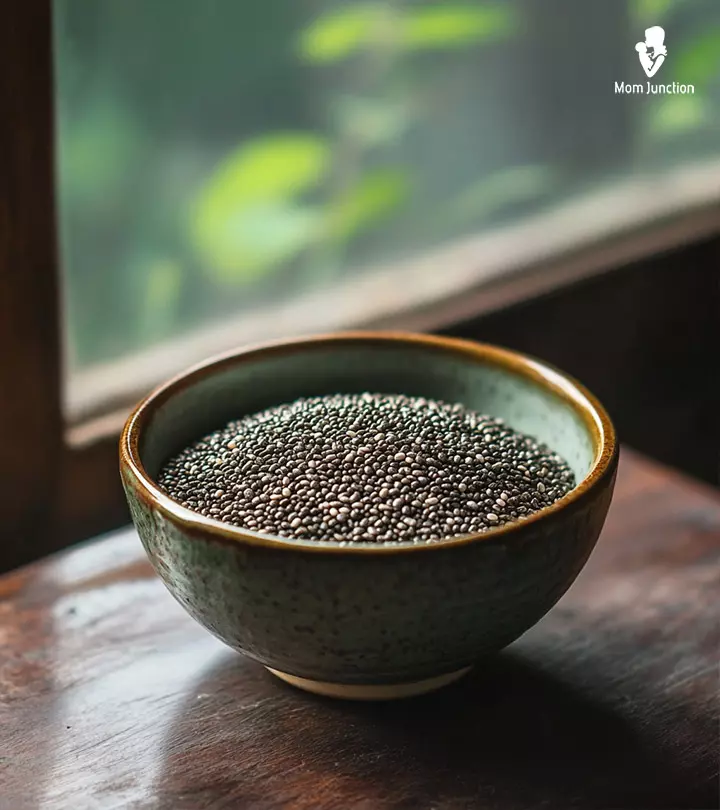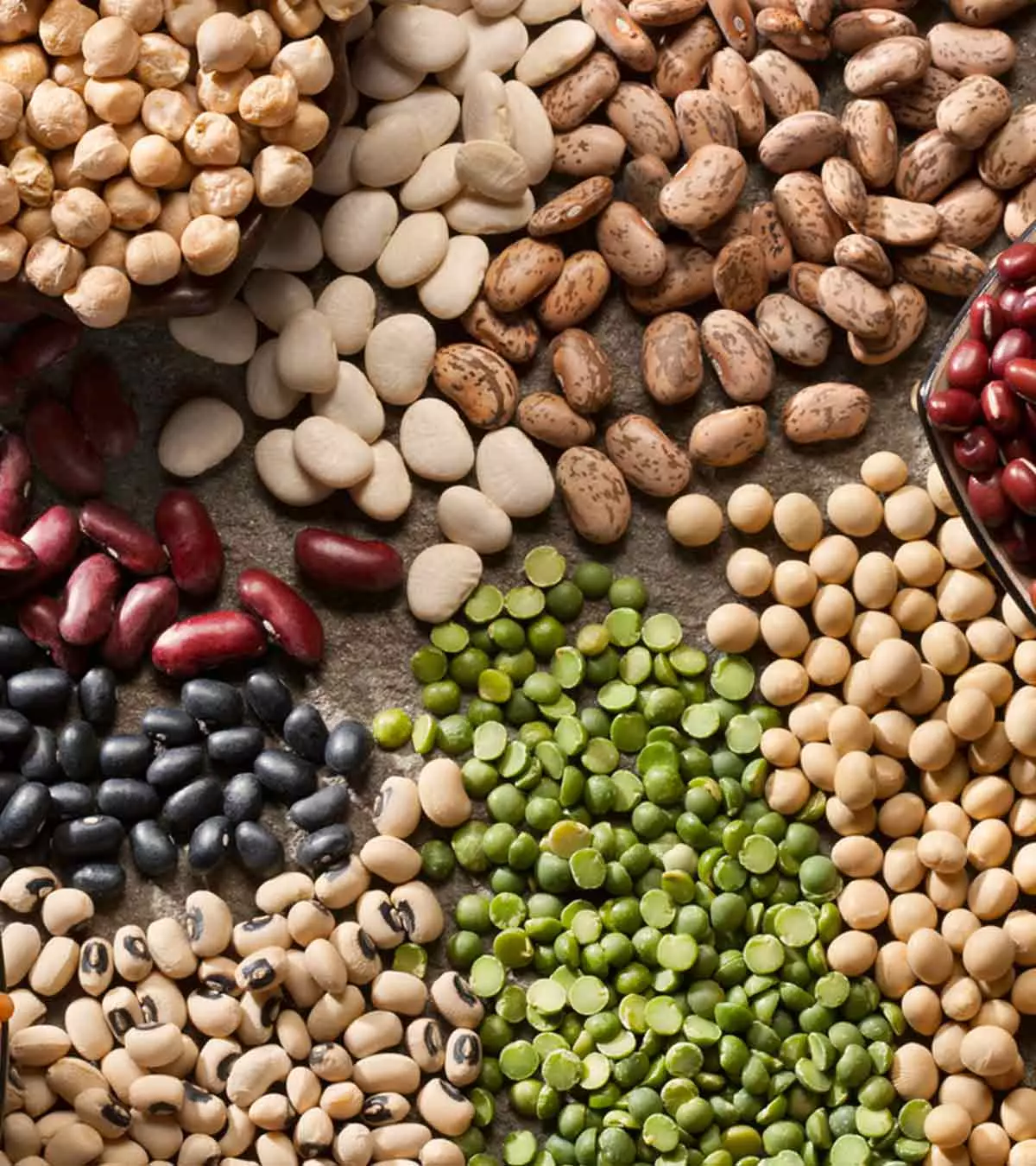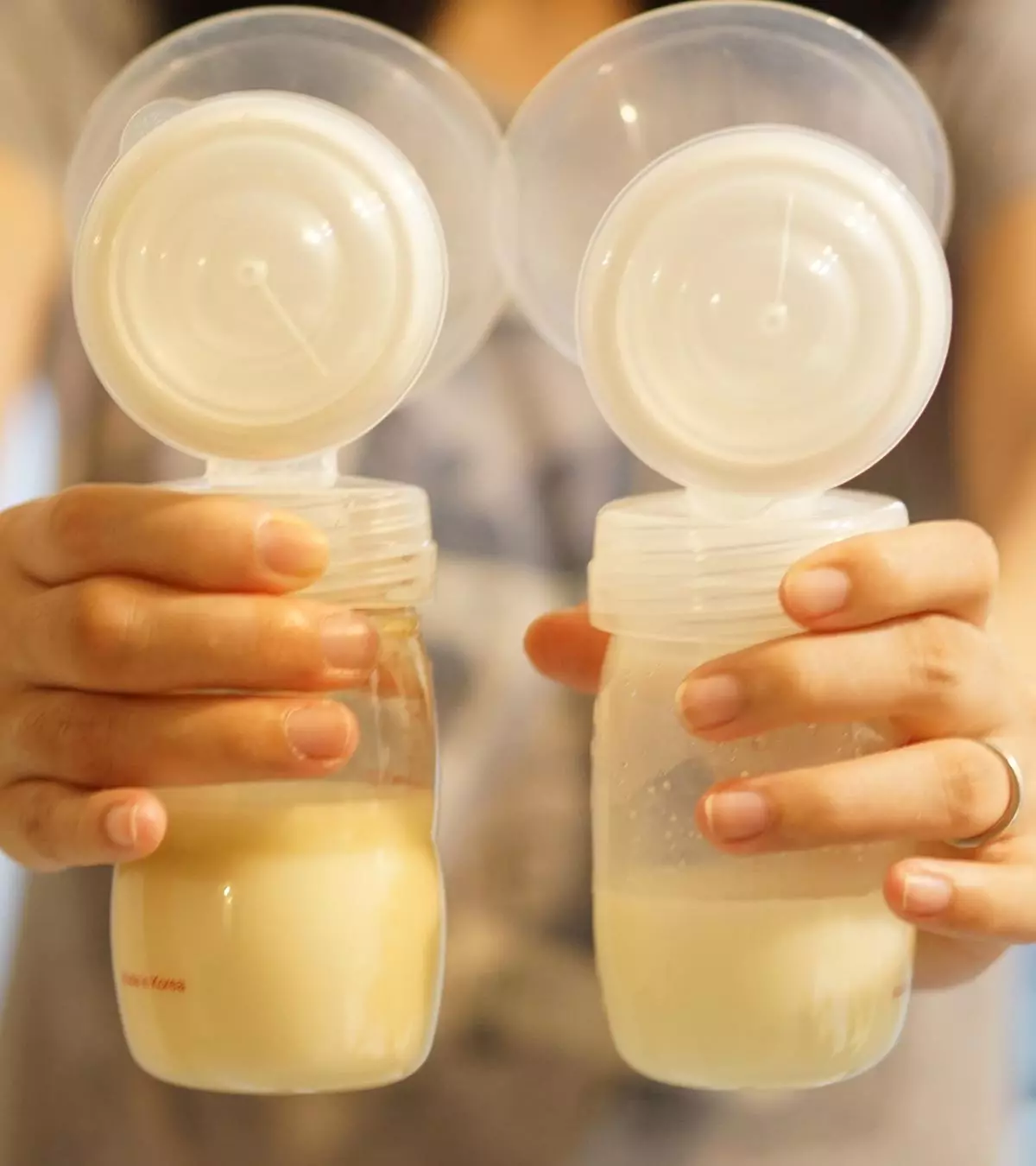
image: Shutterstock

Transitional breast milk is the milk your body produces in the first few days after childbirth. In the first two weeks after delivery, your breast milk transitions through three stages or has three breast milk types — interim (colostrum), transitional, and mature milk. The thick, yellowish-colored, nutrient-rich milk that your breast produces immediately after delivery is called colostrum.
Then, gradually, more plentiful milk called transitional milk comes. Your breasts produce transitional milk for approximately two weeks since birth (1). After that, the breast milk changes into mature milk, which nourishes your baby as long as you choose to breastfeed.
Keep reading to know more about transitional milk’s nutritional composition and benefits for the baby with tips on storing it.
Key Pointers
- The transitional breast milk is produced two to five days after the baby’s birth.
- The milk has a creamy consistency and is mostly bluish-white to creamy yellow in color.
- The milk production varies from one woman to another; however, most produce an average of 500 grams of transitional milk per day.
- This milk contains fat, sugar, calories, and bioactive molecules for the baby’s healthy growth.
When Does The Transitional Breast Milk Phase Begin?

Image: Shutterstock
The second phase of milk or transitional milk is produced approximately two to five days after your baby’s birth (2). As the body begins breast milk production for transitional milk, you may notice a fuller and firmer breasts.
 Things to know
Things to knowHow Does Transitional Breast Milk Look Like?
The transitional milk has a creamy consistency and can range from bluish-white to creamy yellow(3)
. Transitional milk that follows colostrum may be slightly yellow before turning to a shade of blue-white. Bluer milk indicates a higher water content. The color of the milk could become whiter as your breasts begin to produce mature milk. Human milk can be many colors depending on what you eat, the medications you’re taking, and how long it’s been since the last feeding.
How Much Transitional Breast Milk Does Your Body Make?
There is no fixed quantity of transitional milk, and it could vary from one mother to another. A study noted that mothers could produce approximately 500 grams per day of transitional milk from day five since the baby’s birth. However, it may not be the same for all women. Nevertheless, the volume of transitional milk produced is higher than colostrum (4).
Nutritional Value Of Transitional Breast Milk
Transitional milk contains more calories than colostrum, which contains a high concentration of protein and antibodies.
The concentration of breast milk antibodies or immunoglobulins, specifically IgA IgA and IgM, varies in different stages of lactation. IgA is the predominant immunoglobulin in breast milk at any stage of lactation. Transitional milk also has the highest amount of IgA. However, it also has the highest IgM and some IgG.

Immunoglobulin proportions in colostrum, transitional, and mature breast milk
Source: The Breast Milk Immunoglobulinome; NutrientsThe amount of protein and immune factors, such as antibodies in transitional milk decreases slightly as breast milk composition changes from colostrum to transitional milk, but the amount of fat, sugar, and calories increases, benefiting infant nutrition during the developmental phase. Transitional milk also provides essential nutrients like vitamin A, vitamin D, and calcium, which are crucial for your baby’s development.
Breast milk typically contains several bioactive molecules that protect against inflammation and infections. However, the milk subjected to heat treatment or freeze-thaw cycles may not contain the same bioactive molecules as before (5).
Can You Store Transitional Milk?

Image: Shutterstock
Yes, you can store transitional milk. When it comes to storing transitional milk, it is always better to adhere to CDC guidelines to maintain the safety and quality of the expressed or pumped milk. The storage guideline is applicable for all the stages of milk (6).
There are various sources that provide information on how long breast milk can be stored at room temperature, in the refrigerator, and the freezer. Before beginning the process, it is always a good idea to consult with your doctor or a lactation counselor (5).
Breast Engorgement During the Transitional Milk Phase

Image: Shutterstock
Breast engorgement is when milk transitions from colostrum to transitional milk as extra blood and fluid fills the breast to help support making milk. Engorgement also occurs when the breast produces too much milk, causing the breast to become hard, swollen, and painful. Breast engorgement is a common experience that a breastfeeding mother can go through, especially during the transitional breast milk phase.
The breast produces only a small amount of colostrum milk at first, and the transitional milk suddenly increases during the transitional milk phase, causing breast engorgement. A sudden change in feeding schedule, such as skipping a feed or pumping session, can also result in breast engorgement (7).
A mother and blogger reports her experience of breast engorgement, and when she was nursing her son, “Baby G (the baby) would latch on and moments later painfully rip away, fussing and sometimes screaming. This would continue on and off for the entire duration of the feeding. He would splutter, cough, and gag, and he often would pull away during let-downs and get milk sprayed all over his face. I would scramble to get a burp rag to stop the flow while simultaneously holding a wriggling, whining baby. If I wasn’t fast enough, milk would spray into his open mouth, causing him to cough and splutter some more.
“I thought perhaps it was possible that I was producing more milk than my boy needed – I did have engorged breasts if I didn’t nurse soon enough, and I leaked through my nursing pads frequently. Though I doubted that hyperlactation was the cause of my problems, I decided to stop pumping for a few days to see if anything changed, and all of our problems were magically gone (i).”
You should breastfeed your baby whenever the baby shows signs of hunger, every one to three hours, to ensure an easy and trouble-free supply. If you have any questions about breast milk or breastfeeding, please speak with your doctor or a lactation consultant.
 Quick tip
Quick tipFrequently Asked Questions
1. What is considered a low milk supply when pumping?
The quantity of milk you produce depends on your baby’s demand. So, every mother may have a different milk supply. Ideally, within 10 to 14 days of the postpartum period, you start producing 500 to 1000ml of breast milk. However, if you feel you have a low milk supply, check if your baby urinates six to eight times a day, gains weight, and has a seedy stool by the fifth day. See a doctor if needed (8)
2. How long does transitional milk last in the fridge?
Freshly expressed milk may be stored for up to four days in the fridge (4°C or 40°F) (6).
3. Can a baby have trouble digesting or tolerating transitional breast milk?
Generally, babies do not have any trouble digesting or tolerating human breast milk (9 ). However, if you are concerned about any signs of intolerance in your baby, you may approach a pediatrician or a lactation consultant.
4. How can a mother increase her supply of transitional breast milk if needed?
Breastmilk supply in mothers can be increased through the maintenance of regular feeding, expression of breastmilk when full, massaging the breasts while feeding or pumping, and applying warm compresses (110 ).
5. Does transitional milk taste different?
The transitional milk tastes less salty and umami than colostrum, with increased bitterness and sourness (11). For those curious about what breast milk tastes like overall, the flavor can vary based on the stage of lactation and even a mother’s diet.
6. What is the difference between transitional milk and mature milk?
The transitional milk is relatively thin, yellowish-white, and higher in calories, fats, lactose, and water-soluble vitamins than the colostrum. The mature milk is more bluish-white and composed of two parts, the foremilk, and the hindmilk. The foremilk is watery and majorly composed of vitamins and protein. The hindmilk is whitish, thick, creamy, and higher in fat content (1).
The transitional breast milk starts around four to five days after birth. It contains lesser proteins and more calories, vitamins, minerals, and carbohydrate content compared to colostrum milk. This milk is designed to assist your baby in the developmental phase. Its production may make your breasts feel fuller and larger. A few changes that come along this transition are a sudden change in the feeding pattern and an increase in the feeding frequency. If you start to experience breast engorgement, you could start breast pumping for some relief. Ensure you adhere strictly to the CDC’s guidelines on breast pumping, and do not hesitate to speak to a lactation consultant if you have any doubts.
Infographic: Transitional Breast Milk Vs. Mature Breast Milk
Transitional breast milk, as the name suggests, is the milk produced by a new mother after colostrum and before the emergence of mature breast milk. But, how different is transitional breast milk from mature breast milk? Find out in this infographic below.
Some thing wrong with infographic shortcode. please verify shortcode syntax
Illustration: Transitional Breast Milk: What Is It & When Does It Begin?

Image: Dall·E/MomJunction Design Team
Personal Experience: Source
MomJunction articles include first-hand experiences to provide you with better insights through real-life narratives. Here are the sources of personal accounts referenced in this article.
i. Breastfeeding issues: Hyperlactation;
https://pregotolegos.blogspot.com/2014/08/breastfeeding-issues-hyperlactation.html
References
1. Breastfeeding Overview; American Pregnancy Association
2. Transitional Milk and Mature Milk; Healthy Children; American Academy of Pediatrics
3. The Phases of Breast Milk; WIC Breastfeeding Support; U.S. Department of Agriculture
4. M C Neville et al.,Studies in human lactation: milk volumes in lactating women during the onset of lactation and full lactation; The American Journal of Clinical Nutrition (1988)
5. O Ballard and A L. Morrow; Human Milk Composition: Nutrients and Bioactive Factors; Pediatric Clinics of North America (2014)
6. Breast Milk Storage and Preparation; Centers for Disease Control and Prevention
7. Engorgement; WIC Breastfeeding Support; U. S. Department of Agriculture
8. Low Milk Supply; Children’s Hospital of Philadelphia
9. Transitional Milk and Mature Milk; American Academy of Pediatrics
10. Increasing your breast milk supply; Queensland Children’s Hospital
11. Michiko Yoshida et al.; (2014); Taste of milk from inflamed breasts of breastfeeding mothers with mastitis evaluated using a taste sensor; NCBI
Community Experiences
Join the conversation and become a part of our nurturing community! Share your stories, experiences, and insights to connect with fellow parents.
Read full bio of Julie Matheney
Read full bio of Swati Patwal
Read full bio of Rohit Garoo
Read full bio of Anindita Ghatak

















